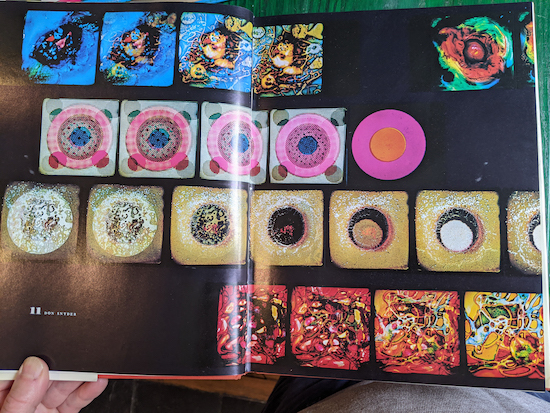Researching my book Retreat: How the Counterculture invented Wellness meant taking a deep dive into the literature around LSD, the Beats, Psychoanalysis, Eastern thought, Yoga, Meditation, Sex and Sensory deprivation. This required me to read nearly five hundred of the wildest books ever written.
The Hindu religion’s concept of Yoga, deriving from the term “yoke” in Sanskrit is explicitly a taxonomy of means by which to achieve ecstatic union with the divine. The Yoga we know from its asana postures is Hatha Yoga and, perhaps ironically, in the subcontinent the most controversial in its claim of being an effective “etheric” technique.
A few other “yogas” are worth mentioning for their exquisite effectivity in generating this dissolutive bliss: Bhakti Yoga the intense focus of devotion and prayer, Nada Yoga the use of divine sound (something which I explored in this extended post), but perhaps most effective of all is Jnana Yoga, the path of knowledge, and which requires nothing so much as the intense study of books. With adroit sleight of hand the author Joseph Campbell claimed to have never had a mystical experience, He made it clear that his spiritual practice consisted of reading, reading, and more reading.
Never costing more than a few pounds, here are a few books that exert a particular fascination as artefacts.
Classical Nutrition by Maximillian Sikinger [Self-published 1946]
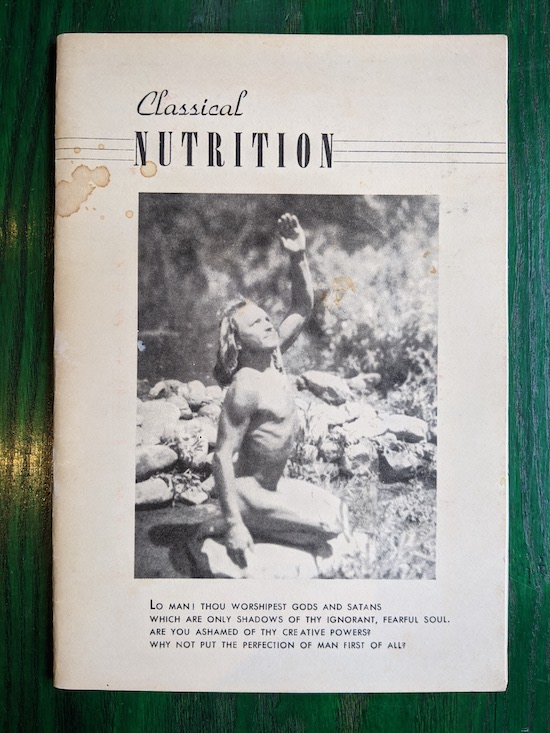
Maximillian Sikinger was one of the original California “nature boys” of whom the singer and songwriter eden ahbez is the most famous example. Max arrived in in the states in 1935 and rode boxcars to California where he lived alfresco in the mountains above Malibu. Here he mentored legendary hippie eccentric Gypsy Boots in the techniques of fasting, special diets and yoga which he had learned in Germany as an exponent of the Lebensreform movement.
Sikinger was a diminutive five-feet tall which was the result of growing up a feral street child in the chaos of inter-war Germany. As a five-year-old at the tail-end of World War One he had been accidentally separated from his mother at a railway station – never to see her again. It is generally accepted that Max, the “little child sad of eyes,” is the subject of eden ahbez’s song “Nature Boy” which became a smash hit when covered by Nat King Cole.
Like Gandhi, another key character in my book Retreat, Max was a firm believer in the power of good health to contribute to the greater good. In “Classical Nutrition,” a slim pamphlet which contains specific dietary advice, he writes “we should in our highest calling within put the utmost effort to create an impersonal unselfish, creative society, in which the individual attains the highest expression and contribution.”
Shivitti – A Vision by Ka-Tzetnik 135633 [Harper&Row 1989]
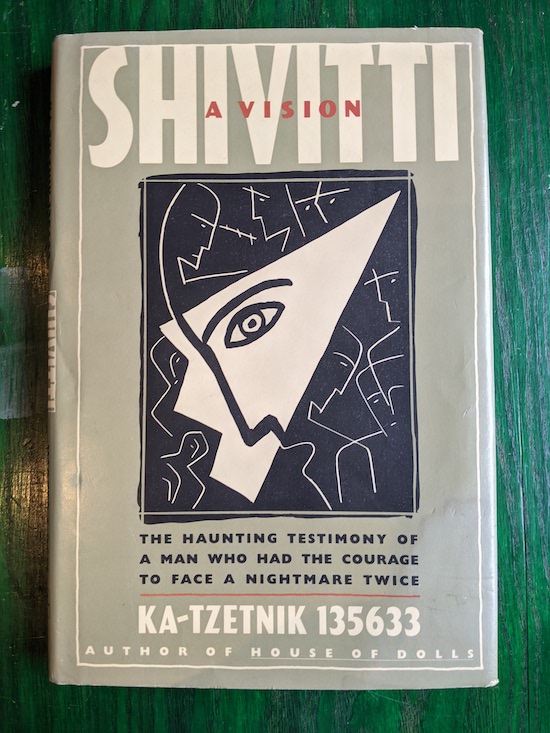
Researching the story of LSD Psychotherapy, I came across the writing of Yehiel De-Nur. De-Nur spent two years in Auschwitz as a prisoner of war. His more famous, equally controversial book is “House of Dolls” [1953] which described the Nazi’s use of Jewish prostitutes and which gave us the term “Joy Division” as used by Ian Curtis and his bandmates. For both books De-Nur used the pen name Ka-Tzetnik, meaning “Concentration Camper” and 135633, his identity number at the camp.
As an attempt to work through the trauma of his experiences at Auschwitz De-Nur underwent LSD Psychotherapy with the Dutch psychiatrist Jan Bastiaans in a programme that had been devised for camp survivors. “Shivitti” is the harrowing account of his experiences in therapy, which at its culmination De Nur believed to have been ineffective.
Love Needs Care by David E.Smith M.D. and John Luce [Little, Brown 1969]
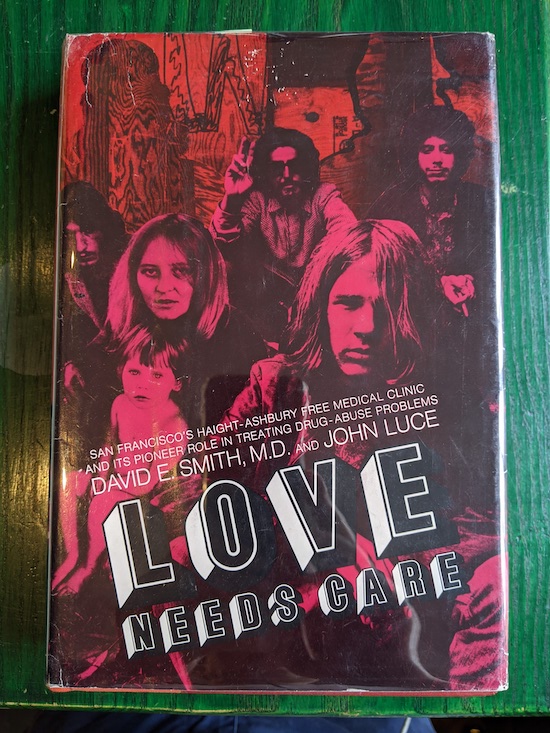
Love Needs Care was written as the day-to-day running of the Haight-Ashbury Free Clinic went from chaos to bedlam. The relative honeymoon of proto-hippies having bad LSD trips and needing talkdown had degenerated into a climate of meth and smack addiction; of young people suffering kwashiorkor, bare feet cut-by-glass infected by dog shit and infants accidentally ingesting psychedelics.
We view of the hippie-era largely through rose-tinted spectacles but here, in sometimes overwhelmingly lurid detail, is its shadow. A fascinating book, it is the immediate background to the Altamont rock festival, where the HAFC provided healthcare and were regrettably unable to save the life of Meredith Hunter. It sheds light on that apotheosis of the hippie dream.
For the book “Retreat” I travelled to the Haight and interviewed the clinic’s founder Dr. David Smith and discovered firsthand, among other things, his spiritual experiences under LSD and his encounters with Charles Manson who, with The Family, frequented the clinic and were closely associated with it.
The Complete Illustrated Book of Yoga by Swami Vishnudevananda [Bell 1960]
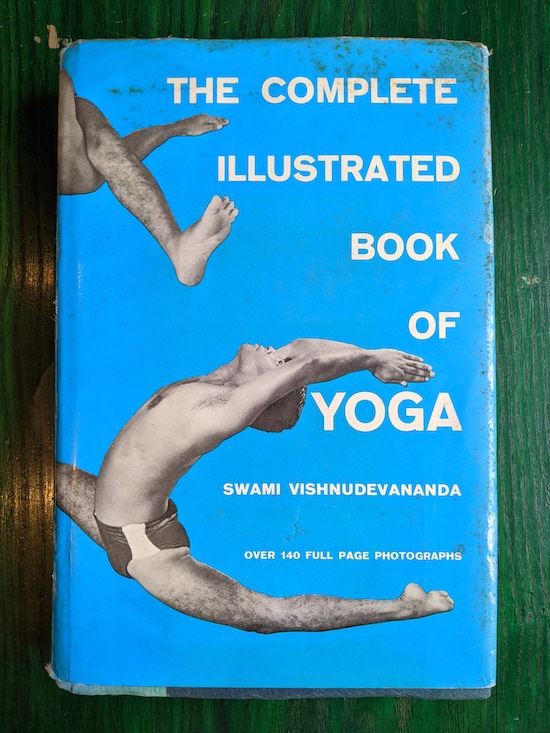
Vishnudevananda, a key pupil of Sivananda and highly respected practitioner of Hatha Yoga, was hired as an extra on the set of The Beatles movie Help!(1965) Here, even before they became involved with Maharishi Mahesh Yogi, he introduced the group to Hatha Yoga and gave George Harrison a copy of this, his book. Copiously illustrated with black and white photography of a myriad of asanas, even before B.K.S. Iyengar’s Light on Yoga [1966] it provided an authoritative guide to the mechanics of Hatha Yoga to a hungry Western audience.
Vishnudevananda was one of the most important conduits of Hatha Yoga to the West, setting up Sivananda Yoga centres in Montreal, the Bahamas, California and in the Catskill mountains. In the early seventies he took to conducting “peace flights” around the world in a small twin-engine Piper Apache aircraft decorated by the artist Peter Max. Vishnudevananda would arrange happenings, for instance a walk through the Belfast streets with Peter Sellers, he would drop flowers and leaflets over Pakistan and India, even flying unbidden over the Berlin Wall in 1983.
Psychedelic Art by Robert E.L. Masters & Jean Houston [Weidenfeld&Nicolson 1968]
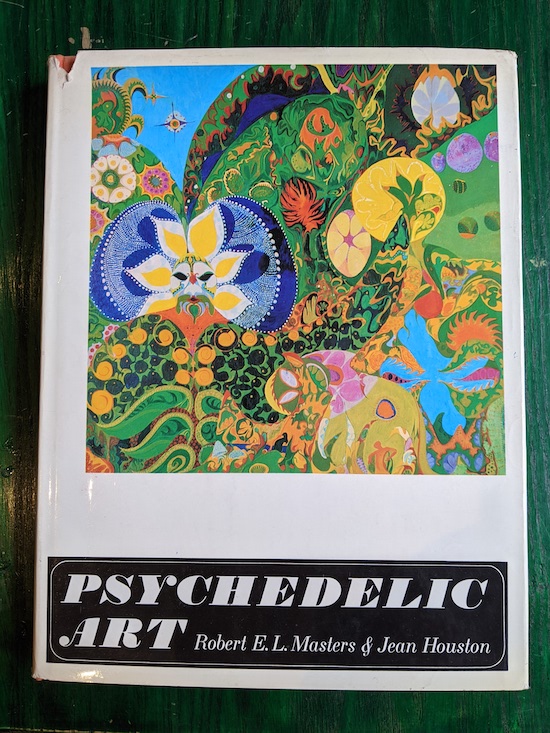
Masters and Houston wrote several books which crystallised the intellectual culture around psychedelics, psychotherapy, and consciousness studies. Their Varieties of Psychedelic Experience (1966) which riffs on the title of William James’ legendary Varieties of Religious Experience (1902) is an exhaustive, always fascinating categorized selection of early trip reports. Their later Mind Games (1972) inspired the John Lennon song of the same name.
One of the key women of the era, Jean Houston had a remarkable childhood as the daughter of one of America’s leading comic writers. In a dressing room, not knowing he had guests, she had witnessed famed ventriloquist Edgar Bergen asking his dummy Charlie McCarthy profound questions about the universe, to which Charlie answered in terms Bergen insisted he was not equipped to furnish. Jean also met the blind and deaf Helen Keller and, astonishingly, had struck up a friendship with the pioneer of consciousness studies Pierre Teilhard de Chardin, who she had literally run into in the street, aged fourteen.
I was grateful to one of my interviewers, the anti-Psychiatrist and colleague of R.D.Laing, Morton Schatzmann, who hipped me to the gorgeous Psychedelic Art.
Retreat: How the Counterculture Invented Wellness by Matthew Ingram is published by Repeater Books

